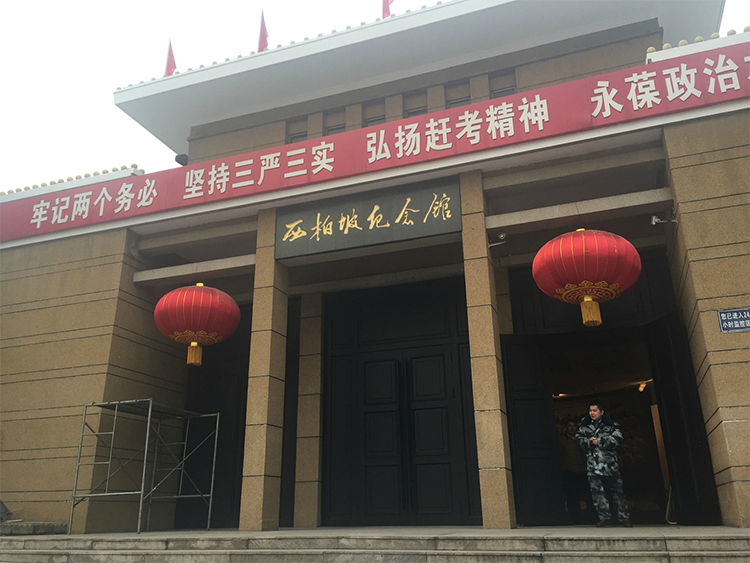Huaihai Campaign Map and Xibaipo Memorial: Visitor’s Guide to China’s Revolutionary Turning Point
Introduction:
Nestled among the pines and jujube groves on the eastern foothills of the Taihang Mountains, a simple compound quietly tells the story of pivotal decisions that changed China. Xibaipo Memorial was the last command post before the Communist Party’s “March to Beijing” and stands as an open-air history text carved into rammed-earth walls and gray-tiled roofs. Here, Mao Zedong and his comrades spent over 200 days planning the three decisive campaigns and laying the foundations for the new China with the famous “Two Imperatives.” Walk through the preserved Central Military Commission operations room and touch the yellowed telegraph drafts to feel how that fervent era shaped today’s China.
1. The Birth and Soul of a Revolutionary Site
As the most complete memorial complex of the Liberation War, Xibaipo goes beyond a conventional museum—it is a living container of revolutionary memory. When the museum was established in 1978, designers deliberately preserved the village’s original appearance: 21 rammed-earth courtyards sit along the Hutuo River, and the dirt paths between jujube trees still follow the layout from 1949 when central organs left the site. This “restore old as old” approach transports visitors straight into the decision-making days; even the air seems to carry the ink of military maps.
2. The Architecture Is the Witness
The main memorial adopts the local Taihang courtyard style: gray bricks and sloping roofs blend harmoniously with nearby residences. The most striking feature is the 1:1 replica of the Central Military Commission operations room: in under 60 square meters, you can see Mao’s kerosene lamp and the exact telegraphs that Zhou Enlai edited. Walking past the “Second Plenary Session of the 7th Central Committee” hall, the worn marks on wooden benches are still visible, as if you could hear the resolute call to “remain modest and prudent.” A 2011 exhibition wing uses modern display technology and a 270-degree panoramic theater to recreate the thunder of the Liaoshen Campaign.
3. Must-See Treasures
– Mao Zedong’s manuscript “Carry the Revolution Through to the End”: written on military stationery, the vigorous, hurried script is stained with ash and tells of sleepless reflection on New Year’s Eve 1948.
– Zhou Enlai’s leather briefcase: the traveling companion from Yan’an to Xibaipo; inner stains show where a fountain pen once leaked.
– Hand-stitched campaign map: a Huaihai Campaign map pieced by local women from patchwork cloth—each stitch an oath of civilian support.

4. An Immersive History Classroom
The permanent exhibition “New China Began Here” unfolds in three chapters:
– Decision Making: digital sand tables demonstrate tactical evolutions of the three campaigns.
– Daily Life: reconstructed vegetable plots and spinning wheels used by leaders reveal wartime domestic routines.
– Spirit: interactive screens let visitors explore original records of the Second Plenary Session.
A highly recommended activity is the “One Kerosene Lamp Until Dawn” night experience—listen to eyewitness oral histories inside a real air-raid shelter by the glow of a lamp.
5. Visitor Flow and Practical Tips
Suggested route:
① Central Old Site (1 hour) → ② Main Memorial Exhibition (1.5 hours) → ③ Stone Inscription Garden (30 minutes)
Best time to visit: early morning at opening for the fewest crowds; late autumn when the jujube leaves turn red provides exceptional photo backgrounds against the earthen walls.
Essential information:
– Admission: Free (ID required)
– Opening hours: 8:30–17:30 (closed Mondays)
– Transport: From Shijiazhuang Passenger Station take the “Xibaipo Special Line” bus (about 1.5 hours)
– Hidden gem: have a postcard stamped at the old-site post office with the authentic “Xibaipo” date-stamp and mail it home.
6. Deeper Experience Suggestions
Combine Xibaipo with nearby Zhengding Ancient City (about a 40-minute drive): spend the morning amid revolutionary history and the afternoon soaking in Tang-dynasty ambiance at Longxing Temple. Try the local “support-the-front big-pot stew,” a communal iron-wok dish that revives the simple, hearty meals once offered to soldiers.

Conclusion:
Standing under the party flag at the Second Plenary Session site, you begin to understand why Xibaipo is called “the place that sets the rules.” It lacks the gilded splendor of imperial palaces but uses the most unadorned rammed-earth walls to express the enduring principle of people first. Carry the spirit you find here onward in your travels—this tucked-away valley holds red memories waiting for the world to listen.


